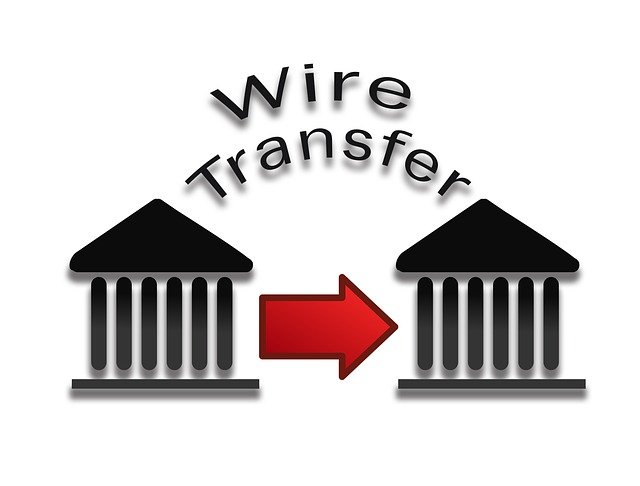Image from Pixabay
This is going to be the ultimate guide to bank to bank transfers for beginners.There are a few different ways that you can actually initiate and complete a bank to bank transfer, and it really depends on what you are using the money for and how much you need to send.
We are going to be discussing all the different kinds of transfers available to you, how they work, and how you can complete them.Let’s get started.
The Different Types of Bank to Bank Transfer

Image from Pixabay
First, let’s talk about what types of transfers you can even complete to move your money from your financial institution to another and how you can initiate them.In this day and age of the internet and technology, especially when it comes to your bank account, it is fairly easy to transfer money at this point. Most of us have online access to our accounts and even apps for our financial institutions. This should mean that all transfers are instant, right?Even though we can make bank to bank transfers online, they do typically take a little bit of time to go through your financial institution’s processing, and then the receiving end’s processing. It’s usually not an instantaneous process.Through this beginner’s guide to bank to bank transfers, we are going to be discussing ACH transfers and wire transfers specifically. These are the most common and effective ways you can move money from one institution to another. While there are other ways, like taking money out of one account physically and depositing it physically into another, technology now makes this much simpler.Like we stated before, the options you have and which one you should go with are going to greatly depend on both how much money you want to send and why you are sending it. Let’s get into what ACH transfer and bank transfers are and which situations they work for individually.
ACH Transfers and How They Work

Image from Pixabay
We are going to start with ACH transfers.So, what is this bank to bank transfer specifically? An ACH transfer, simply put, is making money move electronically between different financial institutions through the Automated Clearing House network, which is one of the biggest payment systems in the United States.Now, this type of transfer is not specific to you sending money to another person. This can refer to pulling funds from an external account to your regular financial institution, paying your bills with your account and routing number, direct deposits from your job or the government (for benefit programs), and third-party apps like PayPal, Zelle, and Venmo.
What Types of ACH Transfers Are There?
how fast the funds are transferred.ACH credit transfers allow you to send money online to either accounts at different financial institutions. These could be other accounts that you yourself own or accounts that belong to your friends or family. Depending on the institutions you are dealing with, you may have to pay a small fee (usually no more than $3.00) to actually send the money.These can be free as well, again, it just depends on your bank. Typically, you really don’t ever have to pay if you are on the receiving end of an ACH credit transfer.ACH debit transfers are a little bit different. These transactions can be set up by you, and they allow money to be pulled out of your bank account to go other places. Typically, this is for paying bills. You set it up either with your bank or with the company billing you itself, and then the funds are pulled using your account and routing number.When it comes to ACH debit transactions, they are typically going to be free of charge for you. However, some companies and financial institutions will charge a fee if the payment has to be expedited in some way. This amount will vary depending on the banks and bill collectors in question.As for third party person to person payments (through PayPal, Zelle, etc.), they may sometimes charge you a small fee as well. Depending on the app/website you are using, and the payment method you choose, it could cost you a few dollars to send funds.
How Long Does It Take to Send the Money?
Even though these are electronic transfers, this does not mean the money is immediately available. Typically, ACH transfers take between 24-48 business hours. This means that holidays and weekends will extend the process, as they aren’t business days.The reason that the money only moves on business days is that the transfers are processed by a physical network operator in only three batches a day.Banks and credit unions can decide whether to have ACH credits processed and delivered within either a business day or one to two business days. As for ACH debits, these transactions must be processed by the next business day. This is based on the rules from the National Automated Clearing House Association, which is the trade group that oversees the network. Once receiving the money, the financial institution may choose to hold the transferred funds for some time, so the delivery time will vary.The National Automated Clearing House Association made a rule that makes sure banks can process payments the same day they are sent, but it’s up to each individual bank whether you are charged for expediting a payment.
Wire Transfers and How They Work

Image from Pixabay
Now that we have talked about ACH transfers, let’s discuss wire transfers and what they are good for.A wire transfer is an electronic transfer of money. Traditionally, a wire transfer goes from one bank or credit union to another one using a network like Fedwire or SWIFT. However, keep in mind that other transfers are frequently referred to as a “wire transfer,” so make sure you clarify what is needed for your transfer.
How Do You Use a Bank Wire?
To wire money, you will typically need to simply submit instructions to your bank. You will need to have information about the recipient’s bank account, which you will have to get from the recipient. When making the request with your bank, you can use a form provided by the bank, or you can call them or submit it online.If you are trying to receive money by wire, then you will need to provide your bank account information to the business or person sending money. Ask your bank for their incoming wire instructions to be sure you are using the correct numbers.Fees are typically around $40 to send a wire, and between $0 and $10 to receive one.
How Long Do Bank Wires Take to Send?
These types of transfers are very useful because the money moves with a day or two. If you are wiring money within the United States, you can even have same-day transfers completed, and international transfers can be done in a day or two. This is why these are usually used for house closings and other important transactions.Because the money moves so quickly, the person receiving the money shouldn’t have to wait for funds to clear before using them. Typically, you won’t see any hold placed on the money from a wire transfer.It may take a few hours for the receiving financial institution to show the wire proceeds in the recipient’s account, even if the money is already there. An employee at the bank may have to finish a few tasks to make those funds available. If you need the money a little faster than it is processing, try calling your bank to see if they can push it along.
How to Utilize Bank to Bank Transfers
Depending on what the situation is, you may need to utilize one bank to bank transfer over the other. Wire transfers are typically better for more “official” transactions like house closings and business transfers. More casual transfers like bills and transfers to friends and family should typically be ACH transfers.Which transfer do you usually prefer?
